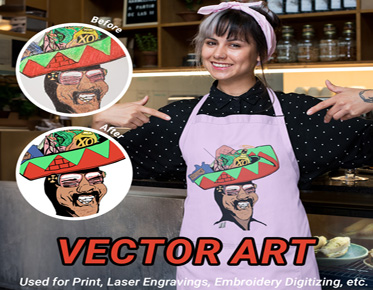Unveiling the Ultimate Fabrics for Screen Printing From Eagle Digitizing
The Art and Science of Screen Printing
Screen printing is a fusion of artistry and technical precision. It's a process that demands not only skill but also the right materials to achieve stunning results. The choice of fabric plays a pivotal role in the final outcome of your screen-printed masterpiece. From the ink's adherence to the fabric's texture, every detail counts in creating a vibrant, lasting print. For the best vector art conversion, please feel free to contact us.
Why Fabric Choice Matters in Screen Printing
The fabric you choose can make or break your screen printing project. It affects how the ink sits, how vibrant the colors appear, and how long the print lasts. A poor fabric choice can lead to faded prints, ink bleeding, or uncomfortable wear. On the other hand, the right fabric can elevate your design, ensuring sharp details and vivid colors that stand the test of time.
Understanding Fabric Types: A Quick Primer
Natural vs. Synthetic Fabrics: What's the Difference?
Natural fabrics like cotton and linen are derived from plants or animals and are known for their breathability and comfort. Synthetic fabrics, such as polyester and nylon, are man-made from chemical processes and often boast superior durability and vibrant color retention. Each type offers unique benefits and challenges for screen printing.
Weave and Texture: How They Affect Print Quality
The weave and texture of a fabric significantly influence print quality. A smooth, tightly woven fabric provides a clean surface for intricate details, while a rough or loose weave might result in uneven ink application. Understanding these characteristics helps select the fabric for your specific printing needs.
Top Fabrics for Screen Printing: A Comprehensive Guide
Cotton: The King of Screen Printing
Cotton is the gold standard for screen printing. Its natural fibers are soft, breathable, and absorbent, making it a favorite among printers.
Breathability and Comfort
Cotton fabrics are comfortable to wear, allowing air to circulate and keeping the wearer cool. This makes cotton ideal for everyday wear and promotional items.
Absorbency and Ink Retention
Cotton's absorbent nature ensures that the ink penetrates well, resulting in vivid, durable prints that stand up to repeated washing.
Best Cotton Blends for Durability
Blending cotton with other fibers can enhance its durability. Cotton-polyester blends, for example, combine the comfort of cotton with the strength of polyester, making them perfect for long-lasting apparel.
Polyester: The Synthetic Champion
Polyester is a powerhouse in the world of synthetic fabrics, known for its durability and vibrant color retention.
Vibrant Colors and Sharp Details
Polyester holds ink well, producing bright, sharp prints that are resistant to fading. It's an excellent choice for sportswear and promotional items that require striking visuals.
Moisture-Wicking Properties
Polyester's ability to wick moisture away from the body makes it ideal for activewear. This property ensures comfort during physical activities, keeping the wearer dry and cool.
Ideal Polyester Blends for Printing
Blends like 50/50 cotton polyester combine the best of both worlds: the softness of cotton and the resilience of polyester. These blends are versatile and highly print-friendly.
Linen: The Luxurious Option
Linen, with its natural elegance, offers a unique texture that can elevate any design.
Crisp Prints on Natural Fabric
Linen's natural fibers produce crisp, clear prints. Its distinctive texture adds a sophisticated touch to the final product, making it ideal for high-end fashion and home décor.
Handling Linen’s Unique Texture
Printing on linen requires careful handling to account for its rough texture. Pre-washing and using the right ink are essential steps to achieve the best results.
Rayon: The Soft and Silky Contender
Rayon offers a silky feel and smooth surface, perfect for detailed prints.
Smooth Surface for Detailed Prints
Rayon's smooth texture allows for intricate, detailed designs to come through clearly, making it a popular choice for fashion items and delicate prints.
Handling Rayon’s Delicate Nature
Rayon can be tricky to work with due to its delicate nature. Proper preparation and gentle handling during the printing process are crucial to avoid damage and ensure high-quality prints.
Blended Fabrics: Combining Strengths
Blended fabrics bring together the best qualities of multiple fibers, enhancing the final product's performance and appearance.
The Benefits of Cotton-Polyester Blends
Cotton-polyester blends are durable, comfortable, and easy to print on. They resist wrinkles and shrinkage, making them a practical choice for everyday wear.
Exploring Tri-Blends for Unique Textures
Tri-blends, typically combining cotton, polyester, and rayon, offer unique textures and benefits. They provide the softness of cotton, the durability of polyester, and the silky feel of rayon, resulting in a versatile fabric that's a joy to print on.
Specialty Fabrics: Going Beyond the Basics
Hemp: The Eco-Friendly Choice
Hemp is gaining popularity for its environmental benefits and robust characteristics.
Durability and Natural Appeal
Hemp is incredibly durable and has a natural, rustic appeal. It's resistant to wear and tear, making it perfect for products that need to withstand heavy use.
Printing on Hemp: Tips and Tricks
Printing on hemp requires a bit of finesse. Pre-treating the fabric and using water-based inks can help achieve vibrant, long-lasting prints.
Bamboo: Softness Meets Sustainability
Bamboo fabric is both eco-friendly and luxuriously soft, making it a fantastic choice for those looking to combine sustainability with comfort.
Eco-Friendly and Luxurious Feel
Bamboo is naturally sustainable and offers a silky, soft feel. It's perfect for high-end apparel and eco-conscious brands.
Achieving Great Prints on Bamboo
Printing on bamboo requires a careful selection of inks and curing methods to ensure the prints are vibrant and durable. Water-based inks work particularly well on bamboo.
Silk: For High-End, Detailed Prints
Silk's smooth surface and luxurious feel make it ideal for high-end, detailed prints.
Smooth Surface for Fine Details
Silk allows for the finest details to come through, making it perfect for intricate designs and luxurious products.
Considerations for Printing on Silk
Printing on silk requires special attention to ink type and curing process to avoid damaging the delicate fabric. Proper preparation and handling are key to achieving stunning results.
Factors to Consider When Choosing a Fabric
Ink Absorption and Retention
The fabric's ability to absorb and retain ink is crucial for achieving vibrant, long-lasting prints. Natural fibers generally absorb ink better, while synthetic fibers may require special inks.
Fabric Stretch and Recovery
Fabrics that stretch and recover well are ideal for activewear and garments that require a snug fit. Consider the fabric's elasticity when planning your designs.
Washability and Longevity
Choose fabrics that can withstand repeated washing without losing their shape or color. This ensures your prints remain vibrant and your garments maintain their quality over time.
Preparing Fabrics for Screen Printing
Pre-Washing: A Must-Do Step
Pre-washing fabrics remove sizing and other chemicals that can interfere with ink adhesion. This step ensures your prints adhere properly and remain vibrant after washing.
Heat Setting for Optimal Results
Heat setting your prints helps to cure the ink and improve durability. This step is especially important for fabrics like polyester and blends that may require higher curing temperatures.
Ink Types and Their Compatibility with Fabrics
Plastisol Ink: The Versatile Choice
Plastisol ink is popular for its versatility and durability. It sits on top of the fabric, providing vibrant colors and excellent coverage.
Water-Based Ink: For a Softer Feel
Water-based inks penetrate the fabric, providing a softer feel. They are ideal for lightweight garments and eco-friendly printing.
Discharge Ink: Creating Unique Effects
Discharge inks remove the dye from the fabric, creating unique, vintage effects. They work best on dark, natural fabrics like cotton.
Common Challenges and How to Overcome Them
Avoiding Ink Bleeding
Ink bleeding can ruin your design. Use proper curing techniques and choose the right ink for your fabric to prevent this issue.
Dealing with Fabric Shrinkage
Pre-washing your fabric helps reduce the risk of shrinkage. Always account for potential shrinkage when planning your designs.
Tips for Printing on Different Fabric Types
Best Practices for Printing on Cotton
Cotton is forgiving and easy to print on. Use water-based or plastisol inks and ensure proper curing for the best results.
Tricks for Printing on Synthetic Fabrics
Synthetic fabrics like polyester require special inks and curing techniques. Use low-bleed inks and avoid excessive heat to prevent dye migration.
Sustainability in Fabric Choices
Eco-Friendly Fabrics for Green Printing
Choosing eco-friendly fabrics like hemp, bamboo, and organic cotton can reduce your environmental impact and appeal to eco-conscious consumers.
Reducing Waste in the Printing Process
Implementing efficient printing techniques and using sustainable inks can help minimize waste and promote eco-friendly practices in your screen printing operation.
Future Trends in Screen Printing Fabrics
Innovative Materials on the Horizon
Emerging materials like recycled fabrics and biodegradable blends are set to revolutionize the screen printing industry, offering new possibilities for sustainable production.
Advances in Sustainable Fabric Production
Advances in fabric production, such as more efficient dyeing processes and lower-impact materials, will continue to drive the industry towards sustainability.
DIY vs. Professional Screen Printing: Fabric Considerations
Choosing Fabrics for Home Printing
For DIY screen printing, start with easy-to-print fabrics like cotton. Experiment with different blends to find what works best for your projects.
When to Seek Professional Help
Complex designs or specialty fabrics might require professional expertise. When in doubt, consult a professional printer to ensure the best results.
Finding Your Perfect Fabric Match
Balancing cost and quality is key to finding the perfect fabric for your screen printing projects. Don't be afraid to experiment with different fabrics to discover what works best for your needs.
Encouraging experimentation and creativity in your fabric choices can lead to stunning results. Continuously educate yourself on new materials and techniques to stay ahead in the ever-evolving world of screen printing. Embrace the art and science of fabric selection, and watch your prints come to life with unmatched clarity and vibrancy.



